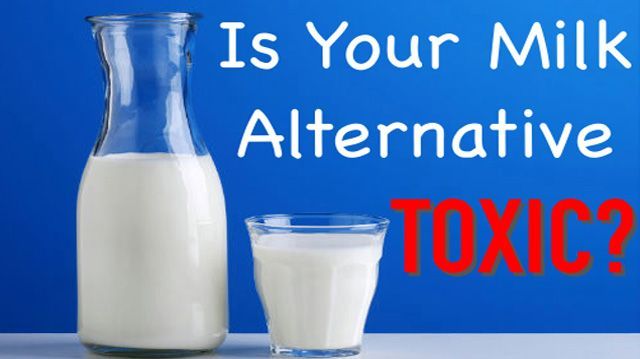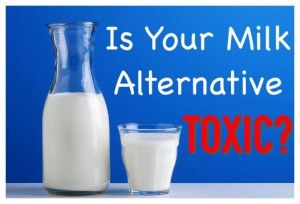
Milk is a contentious subject. Some people swear by its tooth-strengthening and bone-building abilities, while others have gut-wrenching pain whenever they consume it.
A few generations ago, milk may have been a nutritional powerhouse, complete with its own enzymes and healthy bacterium to help with comfortable digestion and absorption.
Nowadays, dairy products have become mass-produced and overly processed. We use milk mostly as a vehicle for, or additive to, unhealthy foods that are ingrained in our culture—things like cereal and coffee. These are not nutritious ancestral foods.
Consequently, when we have trouble digesting the over-processed commercial dairy from the supermarket, we opt for strange manufactured pseudo-milks. Have you ever noticed that nondairy milks often sit on the non-refrigerated shelves in toxic tetra-packs? And how much “milk” is there in a grain of rice anyway?
These pseudo-milks also contain questionable additives, including the following:
Carrageenan: This is a highly inflammatory seaweed-based chemical used as a thickener. It has been shown to damage intestinal lining and cause leaky gut syndrome.
Natural Flavors: This term is a catchall that can hide a lot of mysterious ingredients, like chemically-altered substances, MSG and sweeteners. As long as the substance is from a natural source, it doesn’t matter how altered it is by the time you eat it. It can still be covered by the term “natural flavors.”
Vegetable Oils: These are oils such as canola, sunflower, safflower, corn or soybean, which are rancid industrial products processed with toxic solvents under high heat and pressure.
Soy: The vast majority of soy is GMO and has been shown to damage hormones, lower metabolism, and interfere with protein digestion.
Vitamin D2: This is a synthetic form of vitamin D, which is poorly absorbed and desensitizes D3 receptors, making us more prone to vitamin D deficiency.
Isolated Synthetic Vitamins: These are chemically isolated substances that are not absorbable in this unnatural form. The body doesn’t know how to deal with individual vitamin A molecules, for example, when they are artificially added to “enrich” a food product, separate from their natural cofactors in a complete food.
These artificially extracted and constructed Franken-milks just don’t come close to real organic grass-fed raw milk. The only somewhat acceptable commercial alternative is pure minimally-processed coconut milk in a BPA-free can (the carton versions frequently contain carrageenan).
 It’s also worth noting that dairy is generally much easier to digest in the form of either ghee or kefir. These forms allow you to enjoy all of the valuable fat-soluble vitamins found in milk, without the digestive distress. Ghee is delicious pure vitamin-rich butterfat with the dairy proteins and sugars cooked off. Kefir is a traditional drinking yogurt made with healthy bacterial “grains” that consume the lactose in the milk, leaving a much more easily digestible probiotic product.
It’s also worth noting that dairy is generally much easier to digest in the form of either ghee or kefir. These forms allow you to enjoy all of the valuable fat-soluble vitamins found in milk, without the digestive distress. Ghee is delicious pure vitamin-rich butterfat with the dairy proteins and sugars cooked off. Kefir is a traditional drinking yogurt made with healthy bacterial “grains” that consume the lactose in the milk, leaving a much more easily digestible probiotic product.
Beware of commercial kefir brands with added sugar or sweetened fruit. These will just encourage the growth of pathogenic bacteria in your gut, which will negate the positive effect of consuming the kefir in the first place.
You can also make your own clean and simple replacement milks at home. Try this easy recipe for almond milk:
|
Almond Milk
|
| Prep Time: |
| 1week |
| Cook Time: |
| nocook |
| Total time: |
- 1cup raw organic almonds, soaked overnight
- 4cups pure filtered water
- vanilla bean (optional)
- raw honey(optional)
- Soak almonds for at least 12 hours in pure water with ½ tsp sea salt. This helps break down anti-nutrient substances in the almonds.
- Rinse almonds well. Mix almonds with pure water in blender.
- Blend several minutes until smooth and creamy. (Warning: mixture will expand, so make sure your blender is not full before starting it.)
- Strain mixture into a large bowl through a cheese cloth or kitchen towel.
- Put mixture back into blender with vanilla and raw honey (if using).
- Pour into glass jar or pitcher and store in fridge for up to one week.
-The Alternative Daily
Sources:
http://empoweredsustenance.com/non-dairy-milks
http://www.ncbi.nlm.nih.gov/pmc/articles/PMC1242073
http://www.huffingtonpost.com/dr-mercola/soy-health_b_1822466.html
http://time.com/10093/milk-soy-almond-rice
http://www.thekitchn.com/why-i-stopped-drinking-almond-milk-started-drinking-regular-milk-again-197085
http://www.thehealthyhomeeconomist.com/coconut-and-almond-milk-in-cartons-not-a-healthy-buy
http://wellnessmama.com/366/organic-almond-milk

